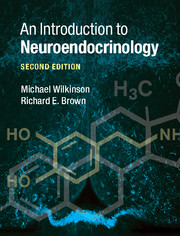Book contents
- Frontmatter
- Dedication
- Contents
- Preface to the second edition
- Acknowledgements
- List of abbreviations
- 1 Classification of chemical messengers
- 2 The endocrine glands and their hormones
- 3 The pituitary gland and its hormones
- 4 The hypothalamic hormones
- 5 Neurotransmitters
- 6 Neurotransmitter and neuropeptide control of hypothalamic, pituitary and other hormones
- 7 Regulation of hormone synthesis, storage, release, transport and deactivation
- 8 Regulation of hormone levels in the bloodstream
- 9 Steroid and thyroid hormone receptors
- 10 Receptors for peptide hormones, neuropeptides and neurotransmitters
- 11 Neuropeptides I: classification, synthesis and co-localization with classical neurotransmitters
- 12 Neuropeptides II: function
- 13 Cytokines and the interaction between the neuroendocrine and immune systems
- 14 Methods for the study of behavioral neuroendocrinology
- 15 An overview of behavioral neuroendocrinology: present, past and future
- Index
- References
5 - Neurotransmitters
Published online by Cambridge University Press: 05 June 2015
- Frontmatter
- Dedication
- Contents
- Preface to the second edition
- Acknowledgements
- List of abbreviations
- 1 Classification of chemical messengers
- 2 The endocrine glands and their hormones
- 3 The pituitary gland and its hormones
- 4 The hypothalamic hormones
- 5 Neurotransmitters
- 6 Neurotransmitter and neuropeptide control of hypothalamic, pituitary and other hormones
- 7 Regulation of hormone synthesis, storage, release, transport and deactivation
- 8 Regulation of hormone levels in the bloodstream
- 9 Steroid and thyroid hormone receptors
- 10 Receptors for peptide hormones, neuropeptides and neurotransmitters
- 11 Neuropeptides I: classification, synthesis and co-localization with classical neurotransmitters
- 12 Neuropeptides II: function
- 13 Cytokines and the interaction between the neuroendocrine and immune systems
- 14 Methods for the study of behavioral neuroendocrinology
- 15 An overview of behavioral neuroendocrinology: present, past and future
- Index
- References
Summary
In general terms, neurons communicate with each other through chemical messengers called neurotransmitters. Given the complexity of the brain, it should not be surprising that there are more than 100 known neurotransmitters (Purves et al. 2008). Neurotransmitters are synthesized in nerve cells, sometimes using precursors from the diet (e.g. tyrosine; see Figure 5.8), and are released into the synapse where they bind to specific receptors located on the postsynaptic cell. As discussed in the present chapter, this simple view conceals the many fascinating ways in which neurons communicate with each other. This chapter focuses on the different categories of neurotransmitters, the synthesis, storage, transport and release of neurotransmitters, their action at receptors and their deactivation. The influence of drugs on neurotransmitter function will also be discussed. Chapter 6 examines the specific effects of neurotransmitters in the neuroendocrine system, and Chapter 10 covers the actions of neurotransmitters at their receptors on postsynaptic cells.
The neuron and the synapse
A typical neuron is shown in Figure 5.1. Neurons possess a cell body, which contains the nucleus, and the characteristic dendrites plus an axon. The dendrites receive messages from other cells onto their spines and shafts, while the axon transmits information to other cells. Although each nerve cell has only one axon, this axon may have a number of branches and the nerve terminals at the end of each branch can form synapses with other neurons.
Nerve cells communicate with each other by the release of neurotransmitters from the nerve terminals of the axon into the synapse, the space that separates the presynaptic and postsynaptic cells. Neurotransmitters released into the synapse then bind to their receptors on the postsynaptic cell. As shown in Figure 5.1, synapses can form between the axon of the presynaptic cell and a number of different sites on the postsynaptic cell, including the shafts and/or spines of dendrites (axodendritic synapses), the cell body (axosomatic synapses) and the axons (axoaxonic synapses).
Information
- Type
- Chapter
- Information
- An Introduction to Neuroendocrinology , pp. 78 - 119Publisher: Cambridge University PressPrint publication year: 2015
References
Accessibility standard: Unknown
Why this information is here
This section outlines the accessibility features of this content - including support for screen readers, full keyboard navigation and high-contrast display options. This may not be relevant for you.Accessibility Information
- 6
- Cited by
